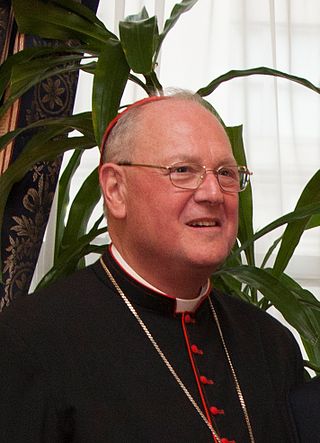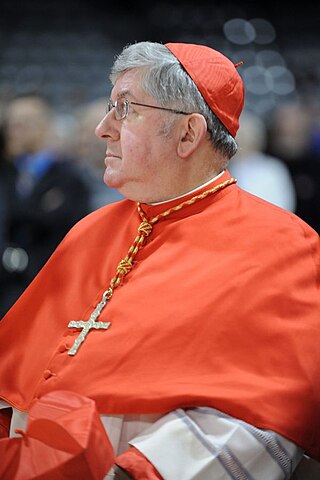Related Research Articles

Bernard Francis Law was an American cardinal of the Roman Catholic Church, known largely for covering up the serial rape of children by Catholic priests. He served as Archbishop of Boston, archpriest of the Basilica di Santa Maria Maggiore, and Cardinal Priest of Santa Susanna, which was the American parish in Rome until 2017, when the American community was relocated to San Patrizio.

There have been many cases of sexual abuse of children by Catholic priests, nuns, and other members of religious life. In the 20th and 21st centuries, the cases have involved many allegations, investigations, trials, convictions, acknowledgement and apologies by Church authorities, and revelations about decades of instances of abuse and attempts by Church officials to cover them up. The abused include mostly boys but also girls, some as young as three years old, with the majority between the ages of 11 and 14. Criminal cases for the most part do not cover sexual harassment of adults. The accusations of abuse and cover-ups began to receive public attention during the late 1980s. Many of these cases allege decades of abuse, frequently made by adults or older youths years after the abuse occurred. Cases have also been brought against members of the Catholic hierarchy who covered up sex abuse allegations and moved abusive priests to other parishes, where abuse continued.

The Archdiocese of New York is an ecclesiastical territory or archdiocese of the Catholic Church located in the State of New York. It encompasses the boroughs of Manhattan, the Bronx and Staten Island in New York City and the counties of Dutchess, Orange, Putnam, Rockland, Sullivan, Ulster, and Westchester. The Archdiocese of New York is the second-largest diocese in the United States by population, encompassing 296 parishes that serve around 2.8 million Catholics, in addition to hundreds of Catholic schools, hospitals and charities. The archdiocese also operates the well-known St. Joseph's Seminary, commonly referred to as Dunwoodie. The Archdiocese of New York is the metropolitan see of the ecclesiastical province of New York which includes the suffragan dioceses of Albany, Brooklyn, Buffalo, Ogdensburg, Rochester, Rockville Centre and Syracuse.

The Archdiocese of Milwaukee is a Latin Church ecclesiastical territory or archdiocese of the Catholic Church headquartered in Milwaukee, Wisconsin in the United States. It encompasses the City of Milwaukee, as well as the counties of Dodge, Fond du Lac, Kenosha, Milwaukee, Ozaukee, Racine, Sheboygan, Walworth, Washington and Waukesha, all located in Wisconsin.

The Congregation of the Legionaries of Christ is a Roman Catholic clerical religious order made up of priests and candidates for the priesthood established by Marcial Maciel in Mexico in 1941. Maciel was also Director General of the congregation for over 60 years until forced to step down in January 2005 as a result of a child sexual abuse scandal.

The canon law of the Roman Catholic Church requires that clerics "observe perfect and perpetual continence for the sake of the kingdom of heaven". For this reason, priests in Roman Catholic dioceses make vows of celibacy at their ordination, thereby agreeing to remain unmarried and abstinent throughout their lives. The 1961 document entitled Careful Selection and Training of Candidates for the States of Perfection and Sacred Orders stated that homosexual men should not be ordained. In 2005, the Church clarified that men with "deeply rooted homosexual tendencies" cannot be ordained. The Vatican followed up in 2008 with a directive to implement psychological screening for candidates for the priesthood. Conditions listed for exclusion from the priesthood include "uncertain sexual identity" and "deep-seated homosexual tendencies".

Diarmuid Martin is the retired Roman Catholic Archbishop of Dublin and Primate of Ireland. Martin was ordained a priest in 1969 and represented the Holy See at major United Nations International Conferences before becoming the Archbishop of Dublin in 2004. Martin has dealt with Catholic sex abuse cases in his tenure as Archbishop. On 29 December 2020 Pope Francis accepted Martin's resignation as Archbishop of Dublin and appointed his successor. The former Bishop of Ossory Dermot Farrell was installed as Martin's successor on 2 February 2021.

Seán Patrick O'Malley is an American cardinal of the Catholic Church serving as archbishop of the Archdiocese of Boston in Boston since 2003. He is a member of the Order of Friars Minor Capuchin and was elevated by the Vatican to the rank of cardinal in 2006.

Timothy Michael Dolan is an American cardinal of the Catholic Church. He is the tenth and current archbishop of New York, having been appointed by Pope Benedict XVI in 2009.
In the Catholic Church, a canonical visitation is the act of an ecclesiastical superior who in the discharge of his office visits persons or places with a view to maintaining faith and discipline and of correcting abuses. A person delegated to carry out such a visitation is called a visitor. When, in exceptional circumstances, the Holy See delegates an apostolic visitor "to evaluate an ecclesiastical institute such as a seminary, diocese, or religious institute [...] to assist the institute in question to improve the way in which it carries out its function in the life of the Church," this is known as an apostolic visitation.

Thomas Christopher Collins is a Canadian cardinal of the Catholic Church. He was the Metropolitan Archbishop of Toronto from 2007 to 2023, the Bishop of Saint Paul in Alberta from 1997 to 1999, and Archbishop of Edmonton from 1999 to 2006. He was elevated to the rank of Cardinal by Pope Benedict XVI on February 18, 2012.

The Archdiocese of Sydney is a Latin Church ecclesiastical territory or archdiocese of the Catholic Church. Its episcopal see is Sydney, New South Wales, Australia.
From the late 1980s, allegations of sexual abuse of children associated with Catholic institutions and clerics in several countries started to be the subject of sporadic, isolated reports. In Ireland, beginning in the 1990s, a series of criminal cases and Irish government enquiries established that hundreds of priests had abused thousands of children over decades. Six reports by the former National Board for Safeguarding Children in the Catholic Church established that six Irish priests had been convicted between 1975 and 2011. This has contributed to the secularisation of Ireland and to the decline in influence of the Catholic Church. Ireland held referendums to legalise same-sex marriage in 2015 and abortion rights in 2018.
The ecclesiastical response to Catholic sexual abuse cases is a major aspect of the academic literature surrounding the Church's child sexual abuse scandal. The Catholic Church's response to the scandal can be viewed on three levels: the diocesan level, the episcopal conference level and the Vatican. Responses to the scandal proceeded at all three levels in parallel with the higher levels becoming progressively more involved as the gravity of the problem became more apparent.
The Curial response to Catholic sexual abuse cases was a significant part of the Church's response to Catholic sexual abuse cases. Its policies have shifted from favoring secrecy in the 20th century to active reform and apologies in the 21st century. Under the current leadership of Pope Francis, the issue has been addressed through direct instructions to report cases of sexual abuse and revoking the former policies of secrecy.

Joseph William Tobin, CSsR, is an American prelate of the Roman Catholic Church. A member of the Redemptorist order, he has been the archbishop of Archdiocese of Newark in New Jersey, since 2017. He previously served as the archbishop of Archdiocese of Indianapolis in Indiana from 2012 to 2016 and as secretary of the Congregation for Institutes of Consecrated Life and Societies of Apostolic Life (CICLSAL) from 2010 to 2012. He has been a cardinal since November 19, 2016.

Ricardo Ezzati Andrello is an Italian-Chilean prelate of the Catholic Church. He was Archbishop of Santiago de Chile from December 2010 to March 2019 and has been a cardinal since February 2014. He previously served as Archbishop of Concepción. He headed the Episcopal Conference of Chile from 2010 to 2016.

João Braz de Aviz is a prelate of the Roman Catholic Church. He has served as the prefect of the Congregation for Institutes of Consecrated Life and Societies of Apostolic Life since his appointment by Pope Benedict XVI in 2011. He began his career working for twenty years as a parish priest and seminary teacher. He became a bishop in 1994 and was bishop of Ponta Grossa from 1998 to 2002, archbishop of Maringá from 2002 to 2004, and archbishop of Brasília from 2004 to 2011.

Charles Jude Scicluna is a Canadian-Maltese prelate of the Roman Catholic Church who has been the Archbishop of Malta since 2015. He held positions in the Roman Curia from 1995 to 2012, when he was appointed Auxiliary Bishop of Malta. Both as a curial official and since becoming a bishop he has conducted investigations into sexual abuse by clergy on behalf of the Holy See and led a board that reviews such cases. He has been called "the Vatican's most respected sex crimes expert". Since November 2018 he has also been an Adjunct Secretary of the Congregation for the Doctrine of the Faith, the curial body responsible for dealing with clerical sexual abuse cases on minors around the world.

The Vatican sexual abuse summit, officially the Meeting on the Protection of Minors in the Church, was a four-day Catholic Church summit meeting in Vatican City that ran from 21 to 24 February 2019, convened by Pope Francis to discuss preventing sexual abuse by Catholic Church clergy.
References
- ↑ "Vatican prepares for Irish visitation" . Retrieved 22 March 2018.
- 1 2 3 4 5 Press Release of the Holy See at the Beginning of the Apostolic Visitation in Ireland Archived 28 July 2011 at the Wayback Machine
- 1 2 "Rome begins planning for Irish visitation" . Retrieved 22 March 2018.
- ↑ Office, Vis-Holy See Press (12 November 2010). "Communique at Beginning of Apostolic Visitation in Ireland" . Retrieved 22 March 2018.
- ↑ Bishops seek to limit Vatican visitation Archived 12 October 2010 at the Wayback Machine
- ↑ Boudinhon, Auguste. "Metropolitan." The Catholic Encyclopedia Vol. 10. New York: Robert Appleton Company, 1911. 13 February 2020
 This article incorporates text from this source, which is in the public domain .
This article incorporates text from this source, which is in the public domain . - ↑ "Bishops summoned to Rome for abuse crisis talks – Independent.ie" . Retrieved 22 March 2018.
- 1 2 3 4 5 "Summary of the Findings of the Apostolic Visitation in Ireland"
- ↑ Letter text Archived 1 October 2011 at the Wayback Machine
- ↑ "Vatican office ordered Irish bishops not to report abuse, report shows : News Headlines". catholicculture.org. Retrieved 22 March 2018.
- ↑ "Unspeakable Crimes". RTÉ.ie . Archived from the original on 15 October 2017. Retrieved 22 March 2018.
- ↑ COMMUNIQUÉ AT THE CONCLUSION OF THE FIRST PHASE OF THE APOSTOLIC VISITATION IN IRELAND Archived 24 June 2011 at the Wayback Machine
- ↑ "Catholic bishops website" (PDF). Retrieved 22 March 2018.
- ↑ "Apostolic visitation: Quotes from Cardinal Dolan's report", The Irish Times, June 15, 2012
- ↑ "Irish College in Rome changes staff after apostolic visitation", Gloucester City News, May 14, 2012